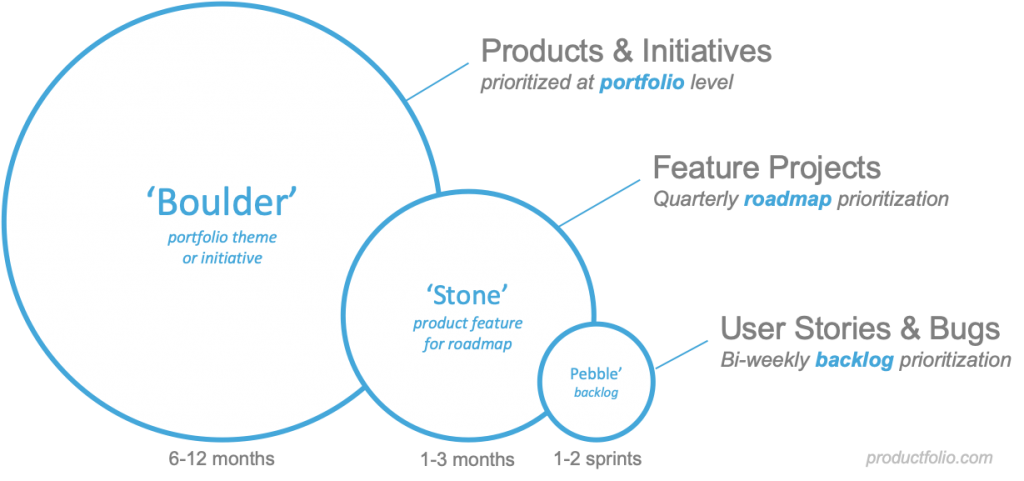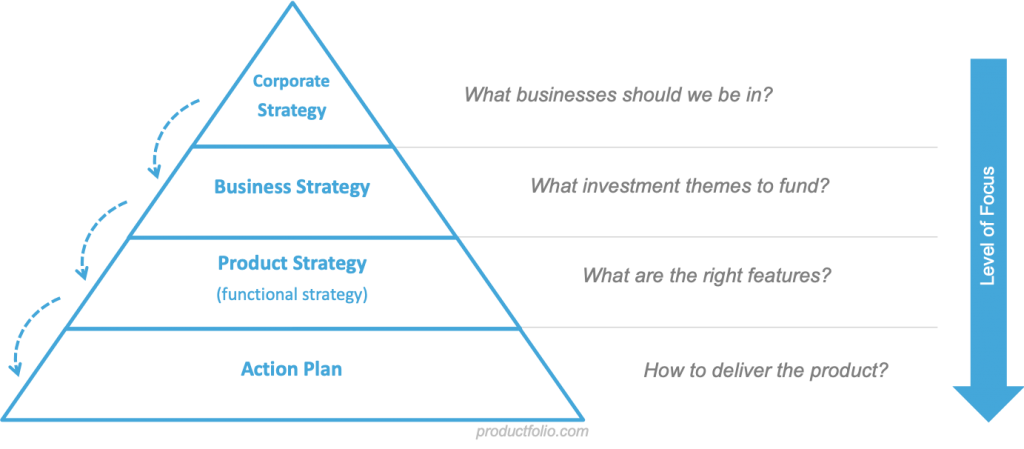Boulders, Stones, and Pebbles for Planning
There are different levels of planning which is easily understood by applying the metaphor of boulders, pebbles, and stones. Boulders are are the largest themes that are often at the business strategy level. This might include major business initiatives, new products, or major focus areas that are expressed as lanes on a roadmap. Stones are the projects that may show on a roadmap and generally correspond to features of the product. Pebbles meanwhile, are the actionable units of work that go into the backlog.

Boulders, pebbles, and stones are related insofar as a boulder can be broken down into stones, and stones can be broken into pebbles. There are some stones that do not come from boulders and pebbles that are not just broken down stones though. For example, pebble-sized requests may come in from stakeholders that require support, A/B tests, or continuous improvement – these may be autonomous and not a part of a larger (stone) project.
Despite their relationship, boulders, stones, and pebbles are generally prioritized separately and by different groups:
Boulder Prioritization – Business will generally set the highest priorities such as boulders and that is often in the context of a Product Council that oversees the product portfolio. The product council is a composition of heads of key teams within the organization that advise business leadership as to the appropriate allocation of budget to the various key themes they are advocating for — but it is fundamentally a business/leadership decision how to allocate those funds. Prioritization decisions at this level are generally informed by a financial model such as Net Present Value (NPV) at this level and this is typically set on an annual basis, leading into the Annual Operating Plan (AOP).
Stone Prioritization – Once Business has set the portfolio budget, it is a signal to the Product team about how to plan and what resources will be available to them. If there are 5 themes, 20 resources, and theme #1 gets 50% of the resources, then they have a team of 10 people to work with and can begin thinking about their roadmap accordingly. To do so, the Product leader for that theme will identify projects (stones) that will facilitate the Product achieving the intended outcome. Product will identify and prioritize those using a more lightweight scoring method such as a prioritization scorecard that ties projects back to goals/objectives,, but seek confirmation with Business that the plan is aligned. This is typically done annually but with a quarterly refresh, since insights and resource available may change.
Pebble Prioritization – Pebbles are mostly requirements that come out of projects, but can also include stakeholder requests, technical debt, A/B testing (Kaizen), and other continuous improvement of the product. These priorities are set every sprint, which is typically every two weeks. Since these are the smallest increments to plan, things are more fluid at this level, and lots of directional guidance has already been provided down to this level, formal prioritization methodologies such as NPV or objective scoring are not generally needed – the team knows what needs to be done in most cases, it’s just a question of the most efficient way to plan the work – particularly if allocation guidance has been provided regarding what percentage of time to spend on roadmap efforts versus requests or continuous improvement.

Four Levels of Strategy
Boulders, Stones and Pebbles reflects a natural hierarchy of planning – large companies generally recognize these four layers though it may be more blurred in smaller companies. Corporate Strategy sets the broadest directional strategy and sets budget for the strategy business units (SBUs). Those SBUs then determine the budgets for their functional departments such as Marketing, Finance, and Product, and provide them goals to achieve along with that budget. Product lives at the Functional level and has cascaded priorities from Corporate and Business strategy to reflect in our planning. Product Management supports business and thus we live within the budget set and seek to achieve the goals/metrics provided to us as part of our implicit (or explicit) charter.
Boulders, Stones, and Pebbles provide a model for understanding the planning and interface between Business Strategy, Product Strategy and the Action Plan. Business (often by way of a Product Council) will set budgets and goals that inform Product Strategy. In so doing, investment themes and strategic initiatives will be surfaced as part of what’s being funded. Those are the ‘boulders’ . That informs themes of the Product strategy and often corresponds to the lanes of a roadmap. The projects that are prioritized and planned by Product and planned into those lanes on the roadmap, are the ‘stones’. And lastly, the requirements and various other requests and continuous improvement tickets that are prioritized in a sprint and pinned to a release plan are part of that action plan. Whether you’re planning a more Agile release plan, practicing Continuous Deployment, or a more regimented Delivery plan for key projects – these are all forms of Action Planning, focused on delivery of the product strategy, just like the product strategy is a strategy for achieving the Business goals/KPIs.


